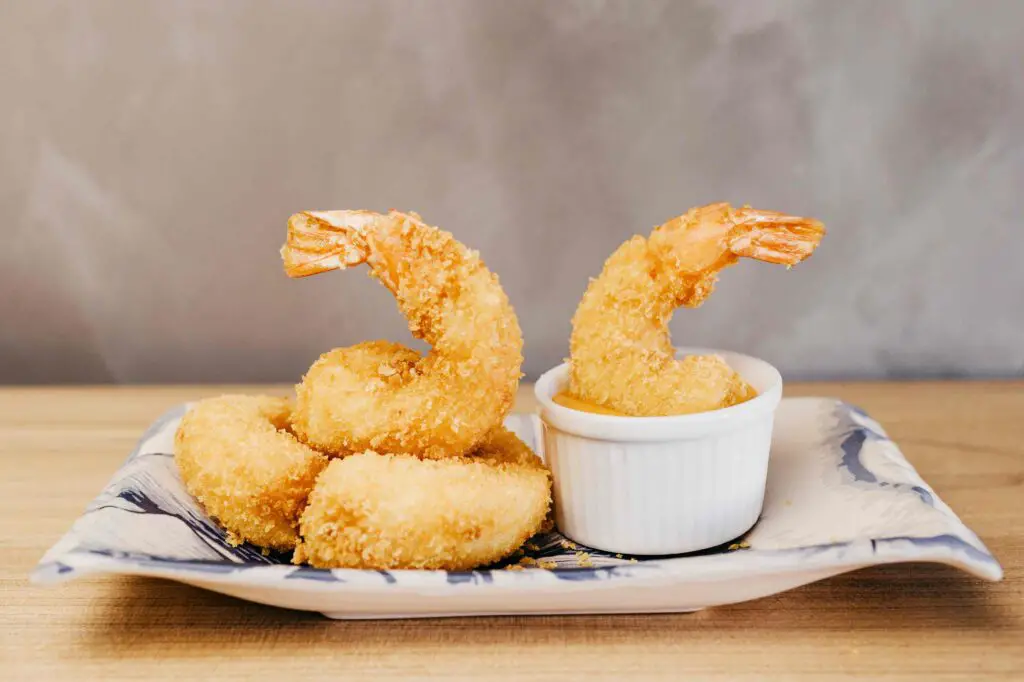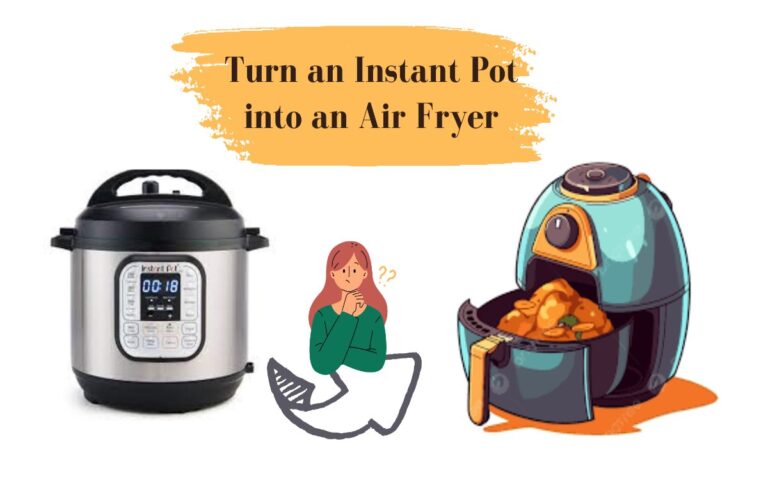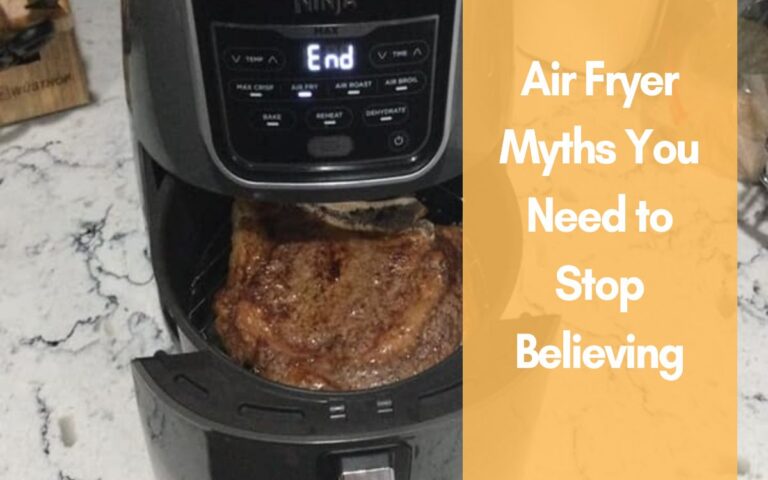Do Air Fryers Make Food Crispy?
If you’re a fan of fried foods but also trying to maintain a healthy diet, you may have heard about air fryers as a healthier alternative.
These kitchen appliances have gained popularity in recent years for their ability to cook food with little to no oil.
They also result in crispy and delicious meals without guilt. But the question remains: do air fryers make food crispy?
In this article, we’ll explore the science behind air frying and whether it lives up to its promise of delivering crispy and healthy meals.

Does an Air Fryer Make Food Crispy?
Yes, an air fryer can make food crispy. This is because air fryers use hot air to circulate the food, which creates a Maillard reaction.
This reaction occurs when heat is applied to the surface of the food, resulting in browning and crisping.
Also, air fryers cook food with little to no oil, which can further contribute to the crispiness of the food.
However, the crispiness of the food can vary depending on several factors, such as the type of food being cooked, the temperature and cooking time, and the amount of oil or coating used.
While some foods may come out perfectly crispy in an air fryer, others may not achieve the same level of crispiness as traditional deep-frying.
It’s important to experiment with different cooking times and temperatures to find the sweet spot for each type of food.
How Do Air Fryers Work?
Air fryers use a process called convection to cook food. Convection is the transfer of heat through a fluid or gas, such as air.
In an air fryer, a heating element heats the air inside the fryer, and a fan circulates that hot air around the food.
This hot air cooks the food and gives it a crispy texture similar to deep-frying.
Most air fryers have a basket or tray where the food sits. The basket or tray has holes or slots that allow the hot air to circulate the food.
Some air fryers also come with accessories like racks or skewers to cook different types of food.
Air fryers typically have adjustable temperature and time settings.
The temperature setting determines how hot the air inside the fryer gets, and the time setting determines how long the food cooks.
Some air fryers such as the Ninja Max XL have pre-set cooking programs for specific types of food, such as chicken or fish.

The Science Behind Crispiness
Have you ever wondered why some foods are crispy while others are not?
The answer lies in the Maillard reaction, a chemical reaction that occurs when proteins and sugars are heated together.
This reaction causes browning and creates the delicious flavors and aromas we associate with crispy foods.
Air fryers work by circulating hot air around the food, creating a similar effect to deep-frying but with less oil.
The hot air causes the Maillard reaction to occur, resulting in crispy and delicious food.
However, not all foods will become crispy in an air fryer.
Foods with a high-water content, such as fruits and vegetables, will not become crispy since the water interferes with the Maillard reaction.
Any foods coated in batter or breadcrumbs may not become as crispy in an air fryer as they would in a traditional deep fryer.
Factors That Affect Crispiness in Air Fryers
Here are some factors that can affect the crispiness of food cooked in air fryers:
- Type of food: Different types of food have different moisture contents and textures, which can affect how crispy they get in an air fryer. Foods that are naturally crispy, like French fries, tend to turn out well in air fryers. Foods with more moisture may not get as crispy.
- Amount of oil: While air fryers use less oil than traditional frying methods, adding a small amount of oil to your food can help it get crispier. Just be sure to use high smoke point oils, like canola or avocado oil.
- Temperature: Cooking at a high temperature is key to getting crispy food in an air fryer. Most air fryers can reach temperatures up to 400 degrees Fahrenheit, which is ideal for getting a crispy exterior. However, cooking at too high of a temperature can also lead to overcooking, overheating, or burning.
- Cooking time: Cooking time can also affect the crispiness of your food. If you cook your food for too long, it may dry out and become less crispy. On the other hand, if you don’t cook it long enough, it may not get crispy at all.
- Size of the food: The size of the food you’re cooking can also affect how crispy it gets. Smaller pieces of food, like chicken wings or shrimp, tend to get crispier than larger pieces, like a whole chicken breast.
By considering these factors, you can increase your chances of getting crispy, delicious food from your air fryer.
Tips for Achieving Maximum Crispiness
While air fryers are known for their ability to make food crispy, there are a few tips you can follow to ensure that your food comes out as crispy as possible:
- Preheat your air fryer before cooking your food. This will help ensure that your food cooks evenly and gets crispy all around.
- Don’t overcrowd the air fryer basket. If you put too much food in the basket, it will not cook evenly and may not get as crispy as you would like.
- Use a light coating of oil on your food. While air fryers are designed to cook food with little to no oil, using a small amount of oil can help your food get crispy.
- Shake the basket during cooking. This will help ensure that your food cooks evenly and gets crispy all around.
- Use the right temperature and cooking time for your food. Different foods require different temperatures and cooking times to get crispy, so be sure to follow the instructions for your specific air fryer and the food you are cooking. Use this air fryer cheat sheet as a guide.
By following these tips, you can help ensure that your air fryer makes your food as crispy as possible.
Also read: Why Won’t My Food Get Crispy in the Air Fryer?
Air Fryers vs. Traditional Frying Methods
When it comes to cooking crispy food, traditional frying methods have been the go-to for many years.
However, air fryers have gained popularity in recent years as a healthier alternative to deep frying.
Here, we will compare air fryers and traditional frying methods to see which one produces crispier food.
Oil Usage
One of the biggest differences between air fryers and traditional frying methods is the amount of oil used.
Traditional frying methods require a lot of oil to deep fry food, while air fryers only require a tablespoon or less of oil to cook food.
This means that air fryers produce food that is less greasy, but also less crispy compared to traditional frying methods.
Cooking Time
Air fryers are known for their fast-cooking time, which is a huge advantage over traditional frying methods.
Since air fryers use hot air to cook food, they can cook food faster than deep frying.
This means that food cooked in an air fryer will be crispy on the outside and tender on the inside in a shorter amount of time compared to traditional frying methods.
Texture
While air fryers produce less greasy food, they may not produce food that is as crispy as traditional frying methods.
Air fryers use hot air to cook food, which may not produce the same texture as deep frying.
However, air fryers can still produce crispy food, especially if you use the right cooking technique and seasoning.
Both air fryers and traditional frying methods have their pros and cons when it comes to producing crispy food.
Ultimately, the choice between air fryers and traditional frying methods will depend on your personal preference and cooking needs.
Conclusion
After conducting various tests and experiments, it can be concluded that air fryers do indeed make food crispy.
The hot air circulation method used by air fryers ensures that the food is cooked evenly and the excess oil is drained away, resulting in a crispy texture.
However, not all foods will turn out crispy in an air fryer.
Foods that are naturally high in moisture content, such as vegetables and fruits, may not become as crispy as desired.
Additionally, the type of food and the cooking time and temperature can also affect the level of crispiness achieved.
- Air Fryer Chicken Parmesan Recipes - September 17, 2024
- Air Fryer Sweet Potato Fries Recipes - August 8, 2024
- Air Fryer Seasoning Mistakes You’re Making - July 22, 2024







